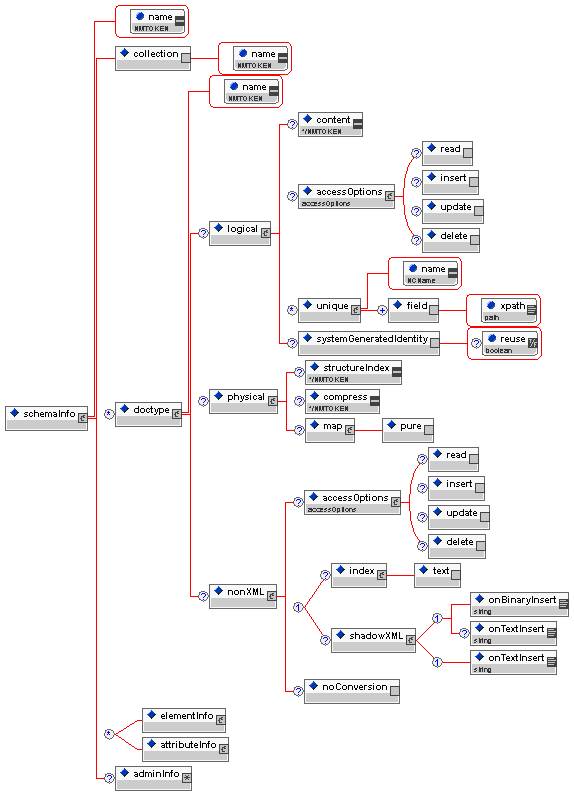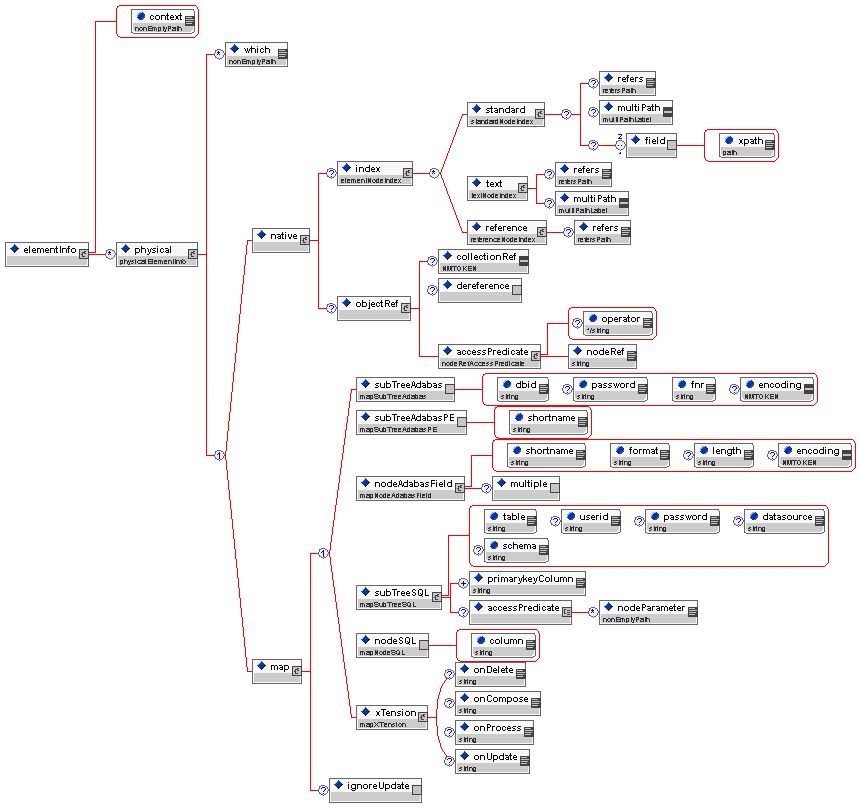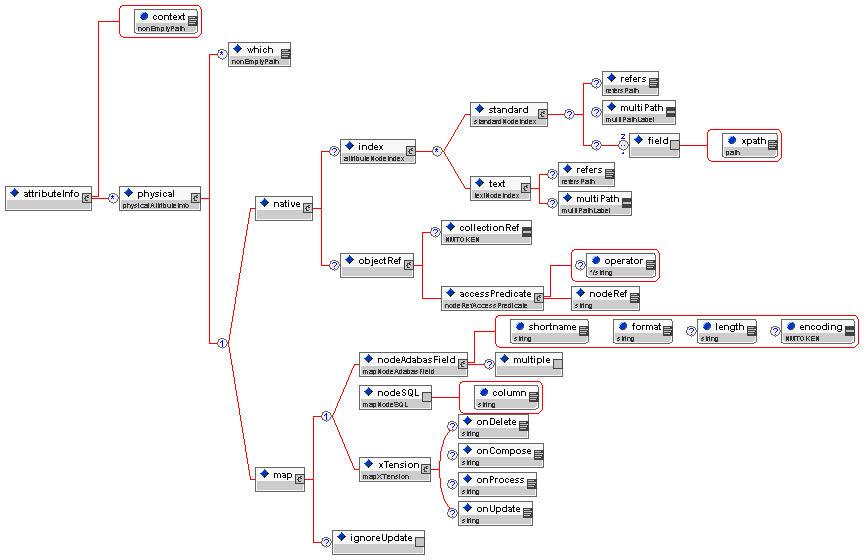All information relevant to the description of a schema that cannot
be expressed in the xs: namespace is located in the
tsd:schemaInfo element
of TSD and its subtree. This is also called the "schema header".
The tsd:schemaInfo element
is embedded into the xs:appinfo element (this is explained
in the section The xs:annotation /
xs:appinfo Mechanism for Adding Tamino-Specific
Extensions).
The following diagram illustrates the content model of the
tsd:schemaInfo element
used under the xs:annotation and
xs:appinfo elements:

Note:
The illustrated
tsd:schemaInfo element is located
under the xs:appinfo and
xs:annotation elements
directly under the top-level xs:schema element in the XML Schema
syntax.
In detail, tsd:schemaInfo contains:
The name attribute.
The meaning of this attribute differs slightly depending on its
context:
- In the context of
tsd:schemaInfoWhen used with the
tsd:schemaInfoelement, the value of this attribute is the name of the schema. For a more detailed description, see the documentation of thetsd:schemaInfoelement.- In the context of
tsd:collectionSee below under The
tsd:collectionChild Element.- In the context of
tsd:doctypeSee below under The
tsd:doctypeChild Element.
The tsd:collection Child Element
The name attribute of the
tsd:collection child
element specifies the name of the collection to be used in cases where this
name cannot be clearly determined. You can also decide at this point whether an
explicit schema is required when processing instances or not: see
tsd:schema.
The tsd:doctype Child Element
The
tsd:doctype child element specifies
the name of the Tamino doctype that the schema
describes. It can also specify logical
and physical storage options and
special options for non-XML data.
The doctype-specific logical storage options provided by this element include
the choice between storage as open or closed
content. The doctype-specific physical
storage options include the possibility of creating a structure
index and the "compress" option.
A single schema can define multiple XML and non-XML doctypes.
The tsd:adminInfo Child Element
The tsd:adminInfo child element contains
administrative information that is associated with the current schema. This
includes version information, creation date and modification date. This
information is generated by Tamino when the schema
is defined. It does not need to be maintained by the schema author.
The tsd:elementInfo Child Element
The tsd:elementInfo child element contains
information that describes an element in the sense of
XML
Schema, and also all relevant mapping or indexing information that
is attached to this structural element. This includes both logical and physical
information:
The logical information included in the
tsd:elementInfo element
contains information about collation handling relevant to the schema, the
definition of action triggers and functions that generate default values. For
more information, see the respective sections of this document.
The physical information relates to indexing, native and
external mapping and object referencing, i.e. linking of different elements. In
addition, the tsd:which element allows you to define
an access path in situations where multiple paths are possible. For more
information, see the section Elements and
Attributes of this documentation.

The tsd:attributeInfo Child Element
The tsd:attributeInfo element contains
both logical and physical information that describes an attribute in the sense
of XML
Schema.
Similarly to the
tsd:elementInfo element, both logical
and physical information is included in the tsd:attributeInfo
element. The information about mapping, indexing and object referencing given
in the section Elements and
Attributes of this documentation also applies to
attributes.

The following example shows a schema for storing data about hospital patients.
Note:
The full schema is given here. The start and end of the schema
header are marked by comments.
<?xml version = "1.0" encoding = "UTF-8"?>
<xs:schema xmlns:xs = "http://www.w3.org/2001/XMLSchema"
xmlns:tsd = "http://namespaces.softwareag.com/tamino/TaminoSchemaDefinition">
<!-- schema for patient data. This could be a fragment of a larger DTD
modeling patient data in a hospital-->
<!-- Start of schema Header -->
<xs:annotation>
<xs:appinfo>
<tsd:schemaInfo name = "patient-schema">
<tsd:collection name = "Hospital"/>
<tsd:doctype name = "patient"/>
</tsd:schemaInfo>
</xs:appinfo>
</xs:annotation>
<!-- End of schema Header -->
...
</xs:schema>
Schema documents defined successfully to
Tamino are stored in the doctype
xs:schema in the collection ino:collection.
Furthermore, a unique document name is generated for each schema document
consisting of the collection name, a slash ("/") and
the schema name. Thus, the schema given above could be retrieved from
Tamino by using the following plain URL
addressing:
http://node_name/tamino/dbname/ino:collection/xs:schema/Hospital/patient-schema
where node_name and dbname are placeholders for the nodename and the database name to be used, respectively.